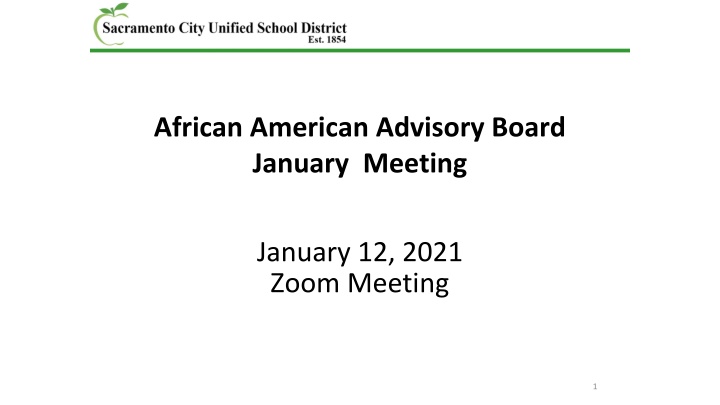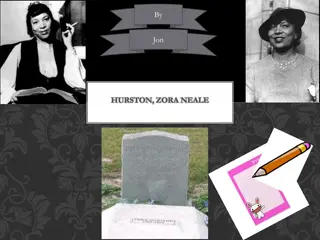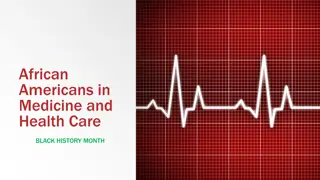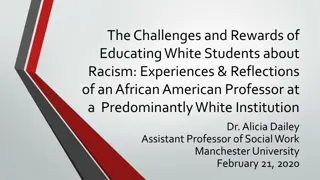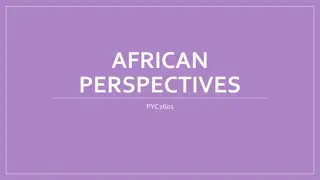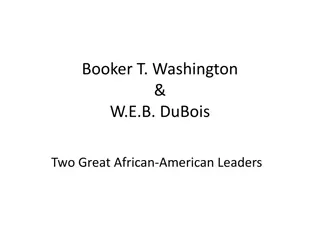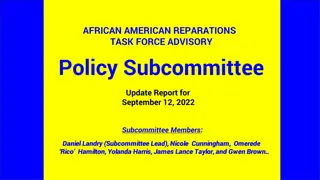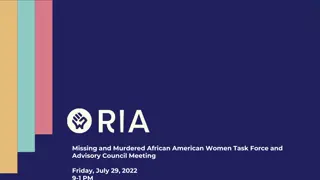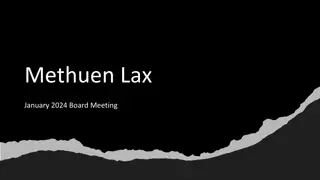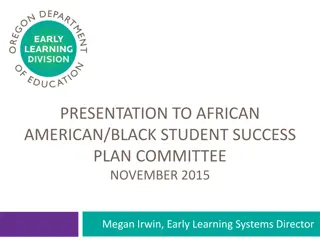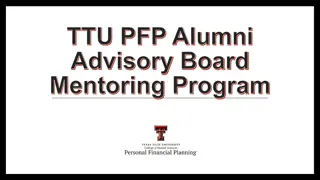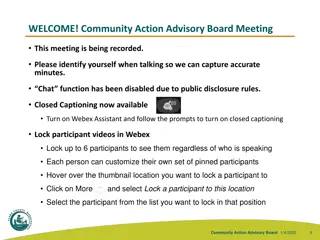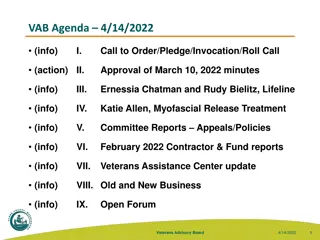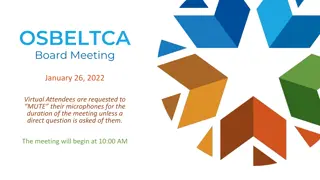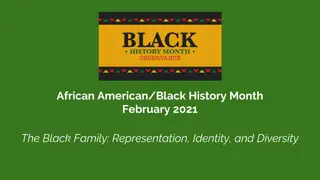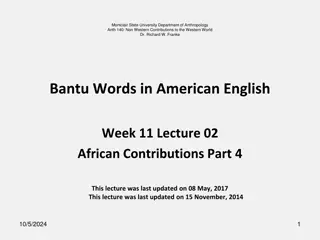African American Advisory Board January Meeting Summary
The African American Advisory Board January meeting on January 12, 2021, was conducted over Zoom. The agenda included reviewing group norms, task force recommendations, updates on the selection process, website review, school reopening updates, district connections, safety task force, fiscal recovery plans, and upcoming topics. Key norms for virtual meetings were outlined, and recommendations for implementation were discussed, with progress noted on several key items. The meeting focused on student support, engagement, data-driven decision-making, and community involvement.
Download Presentation

Please find below an Image/Link to download the presentation.
The content on the website is provided AS IS for your information and personal use only. It may not be sold, licensed, or shared on other websites without obtaining consent from the author.If you encounter any issues during the download, it is possible that the publisher has removed the file from their server.
You are allowed to download the files provided on this website for personal or commercial use, subject to the condition that they are used lawfully. All files are the property of their respective owners.
The content on the website is provided AS IS for your information and personal use only. It may not be sold, licensed, or shared on other websites without obtaining consent from the author.
E N D
Presentation Transcript
African American Advisory Board January Meeting January 12, 2021 Zoom Meeting 1
January 12thAgenda Check In/Student Oriented Opening (10 Minutes) Review of Group Norms (10 Minutes) Brief Review of Task Force Recommendations (1 Minute) Update on AAAB Selection Process Applications/Interviews (45 Minutes) AAAB website: https://www.scusd.edu/aaab Review and Adopt Selection committee board member recommendations School Re-Opening Update and decide on potential response (30 Minutes) Updates from District Connections (15 Minutes) Re-Imagine Safety Task Force Fiscal Recovery Plan SCUSD Board of Education Meetings January 14th Re-Opening Metrics February 4thand February 18th(present AAAB membership and key talking points) February Topics Pipeline (5 Minutes) 3
Group Norms 1. Be student-focused and trust that everyone comes with a desire to support students, the AAATF recommendations and implement the Task Force work 2. Come ready to be engaged 3. Step Up, Self-Regulate and Step Back 4. Stay on topic in discussion: use the parking lot for thoughts that are not on topic 5. Use evidence and data to drive inquiry and support recommendations 6. Provide one voice in Board Communications 7. Strive to attend all meetings; if you miss a meeting, it is your responsibility to find out what was covered. 4
Norms for Virtual Meetings Do not multi-task (do other work) during the meeting. Use the mute button at your site to prevent the transmission of background noise. Speak up to get attention if you have something to say. Turn on your video whenever possible. Follow an organized line up to ensure each person has a chance to respond 5
Recommendation Implementation (Bold Items Have Been Implemented) Recommendation Up to 1 Year Up to 2 Years Up to 3 Years 1. Establish a District-wide Black/African American Parent/Caregiver and Student Advisory Board 2. Establish a Black/African American Student Achievement Task Force Implementation/Accountability/Parent Engagement Steering Sub Committee (s) 3. Require sites with over 5% variance on suspension rate disproportionality to develop and implement a plan to reduce suspensions to at least the district average 4. Eliminate willful defiance suspensions (Senate Bill 419) 5. Implement multiple measures to assess student progress in order to identify students in need of intervention and prioritize resources X x X X x 6. Implement research based intervention and acceleration strategies to close persistent learning gaps x 7. Provide school-to-college and school-to-career experiences utilizing community stakeholders (career training, university shadowing, mentoring and internships, etc.) X 8. Divest from future funding for school resource officers and reinvest in alternative supports X 9. Create a District-wide study team tasked to review, monitor K-12 special education referral practices x x 10. Adopt and implement curriculum that includes and reflects Black/African American experience x x 11. Provide professional development addressing inequitable disciplinary practices and mandate 100% faculty and staff attendance 12. Eliminate Pre K 3rdgrade suspensions 13. Increase Black/African American teachers from 109 to 150 x x x x x x x x x 6
Revised Recommendation Framework Organizational Infrastructure: Recommendations Implemented and Require AAAB Progress Monitoring #2 Establish a Black/African American Student Achievement Task Force/Advisory Board (#1 embedded as a subset of the AAAB) Culture and Climate: Recommendations Implemented and Require AAAB Progress Monitoring #3 Require sites with over 5% variance on suspension rate disproportionality to develop and implement a plan to reduce suspension to at least the district average #4 Eliminate willful defiance suspension (Senate Bill 419) #8 Divest from future funding for school resource officers and reinvest in alternative supports #12 Eliminate Pre K-3rdgrade suspension Proposed Revision of Academic Achievement Recommendations: The District will use its current Title I, III, and Mitigation of Learning Loss funds to immediately identify, assess, monitor, and provide research-based tiered intervention (remediation to acceleration) strategies to address the persistent learning gaps for its Black/African American student body. (Addresses recommendations #5, #6 and #9) - immediately address learning loss pre/during/ after COVID-19 with all available resources for black/African American students The AAAB will identify and recommend a list of vetted and qualified vendors able to provide professional development opportunities addressing inequitable disciplinary practices, pre-college and career planning, and curricular and programmatic resources reflecting Black/African experiences. The list will be presented to SCUSD leadership to take action and integrate into the professional learning calendar (Addresses recommendations #7, #10, #11) - Stand-alone recommendation: #13 7
AAAB Selection Process Update Selection member participation 7 committee members Jan 4 6 committee members present Jan 5 7 committee members Jan 6 5 committee members January 9th 4 committee members 25 total Applicants Interviewed Selection Criteria Deliberation Emerging Board Member Categories based on Applicant interviews Selection Committee Recommendation 10
Share Screen : .1.) Selection Committee Recommendations (Matrix) 2.) First Meeting Recommendation (February)
CDPH/SCPH Reopening of Schools Criteria County Risk Level Adjusted Case Rate Positivity Rate Health Equity December 1st 26.6 9.4% n/a December 8th 31.6 10.3% 13.7% Regional Stay at Home Public Health Order - 12.7% ICU capacity December 10th January 5th 12.1% 16.0% 47.0
Return Together Vision Statement Sac City Unified will disrupt the current status quo of systemic inequity to meet the academic, social and emotional needs of all our students, especially our most vulnerable students. Such disruption must result in higher learning standards and accountability. Our Return Together Plan will abide by all county public health orders to safely serve as many students as possible through in-person instruction. Because we recognize the evolving nature of this pandemic, all of our learning models will meet the needs of all students and mitigate learning loss, assuring that all students are given an equal opportunity to graduate with the greatest number of postsecondary choices from the widest array of options. 15
Greater Sacramento Area Regional Stay At Home Public Health Order The following school activities are allowable: Distribution of essential services, such as all meal/food distribution, educational supplies and health services (i.e. immunizations & flu vaccines) Specialized service, such as occupational therapy, speech and language, medical or behavioral health services Small groups/cohorts, such as the SCUSD Learning Hubs Elementary school waiver applications Youth sports conditioning - outdoors only
Implications for Purple Tier Schools not already open to all students for in-person instruction must remain closed Schools conducting in-person instruction or supports must maintain mitigation measures, including social distancing, face coverings, and sanitization, in compliance with schools guidance from CDPH and Sacramento County Public Health. Counties must remain in an assigned tier for a minimum of three weeks and must meet the criteria for the next tier for two consecutive weeks before advancing to the next tier. 17
Learning Hubs and Waiver Applications Learning Hubs are allowable under the preexisting CDPH small groups/cohort guidance. Cohorts cannot exceed 16 individuals per cohort or more than 25% of the entire school population. Elementary schools (grades TK-6) may apply for a waiver to conduct in- person instruction. No waiver process exists for middle or high schools. Outdoor only sports conditioning using equipment is allowable for physical education classes and student athletics. 18
Governors Safe Schools for All Plan Four Pillars 1. Safety & Mitigation. To further ensure health and safety in the classroom, the Administration will focus on implementation of key measures, including testing, PPE, contact tracing, and vaccinations. Testing. The Administration will support frequent COVID-19 testing for all school staff and students, including weekly testing at schools in communities with high rates of transmission. For example, any interested public school will be on-boarded to the state-owned Valencia Branch Lab for PCR tests at one-third the market rate and the State will establish a hotline to help schools implement testing. PPE. All staff and students in schools are required to wear masks. Furthermore, surgical masks will be recommended for school staff, and the Administration will distribute millions of surgical masks to schools at no cost. The Administration has also enabled schools to leverage state-negotiated master contracts for PPE to reduce costs and streamline supply chains. Contact Tracing. Schools will continue to be on-boarded onto the School Portal for Outbreak Tracking (SPOT) to improve collaboration between school and health officials, and members of the state contact tracing workforce will be deployed to improve communication with schools. Vaccinations. School staff will be prioritized in the distribution of vaccines through the spring of 2021. 19
Governors Safe Schools for All Plan Four Pillars 2. reopening of schools beginning in February, with a priority for returning the youngest children (TK-2nd grade) and those who are most disproportionately impacted first, then returning other grade levels to in- person instruction through the spring. These funds will provide approximately $450 per student to school districts offering in-person instruction and will be weighted for districts serving students from low-income families, English learners and foster youth. Funding. The Budget will propose for immediate action in January, $2 billion for the safe 3. transmission in schools, will lead the Safe Schools for All Team, a cross-agency team composed of dedicated staff from CDPH, Cal/OSHA, and educational agencies. The Team will provide hands-on support to help schools develop and implement their COVID-19 Safety Plans. These supports include school visits and walk-throughs as warranted, webinars and training materials, and ongoing technical assistance. Oversight & Assistance. Dr. Naomi Bardach, a UCSF pediatrician and expert on COVID-19 4. reopening status, level of available funding, and data on in-school transmissions. Additionally, a web- based "hotline" will empower school staff and parents to report concerns to the Safe Schools for All Team, which will lead to escalating levels of intervention, starting with technical assistance and ending with legal enforcement. Transparency & Accountability. A state dashboard will enable all Californians to see their school's 20
Key operational Aspects of Governors Plan The sum of $2 billion one-time Proposition 98 General Fund is available for in-person Instruction Grants Public schools, with the exception of non-classroom based charter schools, may apply for grants through one of three processes (see next slide) Funds will be audited as part of the 2021-22 annual audit process to ensure compliance with grant requirements. Funds are available for use until December 31, 2021 and may be used for any purpose consistent with providing in-person instruction All Districts in counties in Purple Tier must submit their COVID-19 School Safety Plan to their local health jurisdictions Disapproval of the COVID-19 School Safety PLan will render the district ineligible to receive grant funding 21
Key operational aspects of Governors Plan Submit application to County Office of Education Funding Rounds and Initial Application Date Round 1 (February 1, 2021) Round 2 (March 1, 2021) Round 3 - Available to districts in counties above 28 per 100,000 COVID-19 rates (February 1, 2021 or March 1, 2021) Application Materials Required A completed COVID-19 School Safety Plan A copy of ratified certificated and classified collective bargaining agreements Actions Required by Application Date Post the COVID-19 School Safety Plan publicly on district website homepage Certify that each of its pupils participating in distance learning has access to a computing device, software and high-speed internet access necessary to participate in online instruction 22
African American Advisory Board/Black Parallel School Board Re-Opening Observations and Decide Next Steps What will be the instructional protocols to ensure that the grouping works and students are completing task as intended? Will there be additional cooperative learning training/support for teachers who need it? Are surveys the best way to gauge student emotional well-being? What happens to students who need agency referrals outside of the school community for targeted support? What is the plan for these supports to be available? With Pupil Learning Loss how do they plan to do weekly communications to parents on goals, content, and assessment of students. Also, what support will they provide students to compensate for the loss? UDL requires tremendous supports to help our teachers who are presently struggling with differentiation of curriculum and assessment. How will the district provide these supports? How will students be exempted from participation in synchronous platforms? What specific record keeping will be used to report suspensions or time frames where students have been removed from online teaching? How will decisions be made by instructional staff to remove students from synchronous systems? Who decides the time frame of the removal? Besides time out or virtual calming rooms what other supportive programs will the district offer to keep students engaged and motivated to participate appropriate in synchronous platforms? How will missed work be handled for students removed from instruction? What systems and forms will be used to manage student participation and suspensions? 23
Strategic Connections Who do you represent Re-Imagine School Safety Task Force Update Upcoming SCUSD District Board Meeting Topics January 14thBoard Meeting Conditions for Re-Opening of School Governor s Budget Update February 4thand 18th 24
Topic Pipeline for February 3rd Meeting Topics AAAB Re-start everyone invited (current and new) Share experiences and overview Ask questions of current board members Sign letter of commitment (new and current board members missing XX meetings) Send commitment letter before February 3rd welcome and overview Grounding for new board Board Member Introductions Board Member commitment Revisit Norms Overview of the Advisory Board evolution Overview of available African American student district data Recommendations to impact the spring re-opening process Executive Committee Selection Re-Imagine Safety Task Force (update) SCUSD Board of Education presentation (2/18) 25
Concern about Recommendation #8 Divest from future funding for school resource officers and reinvest in alternative supports Oakland Unified School District has created its 200 page Re-Imagine safety plan this could be a Some concern about our current effort with the Re-Imagine Safety Task Force progress as it relates to Recommendation #8 How does the Fiscal Recovery Plan impact the Re-Imagine Safety Task Force? Are there additional resources that we can provide to support the overall Task Force infrastructure? Are there opportunities to accelerate the Task Force work? Is there an opportunity to create a targeted force? Concern that the current Task Force work may need to be re-aligned with the original Re-Imagine Safety board resolution the original resolution may be too narrow in scope to actually meet the overall spirit of the district mandate may need the board of education to expand the scope to resolve the long standing root causes Darryl will send out the Oakland Unified School District Re-imagine safety plan The original timeline may have been too aggressive (e.g. AAATF) There may be a need for greater conflict resolution support in order to help the group move past the natural challenges Darryl will draft language to define how the AAAB can directly support the Re-Imagine safety task force send to full AAAB and the superintendent 26
Next African American Advisory Board Meetings 5:30 to 7:30PM via Zoom February 3rd March 3rd April 7th May 5th June 2nd 27
